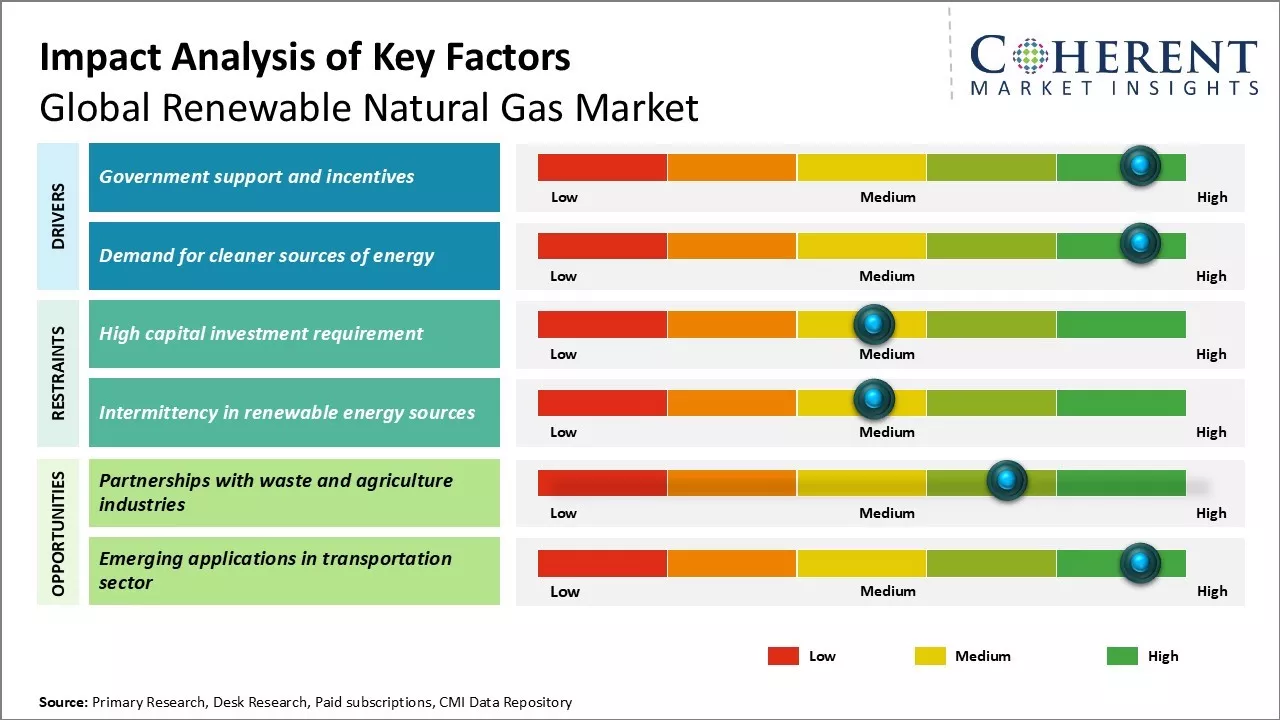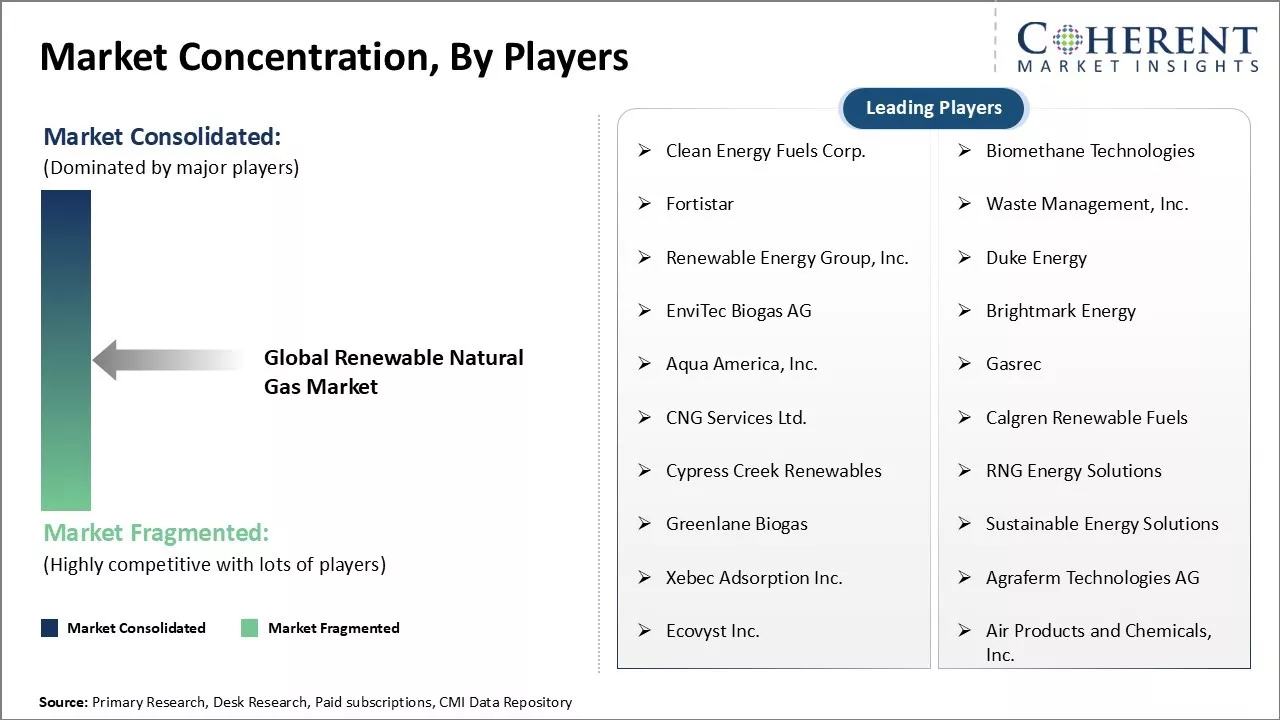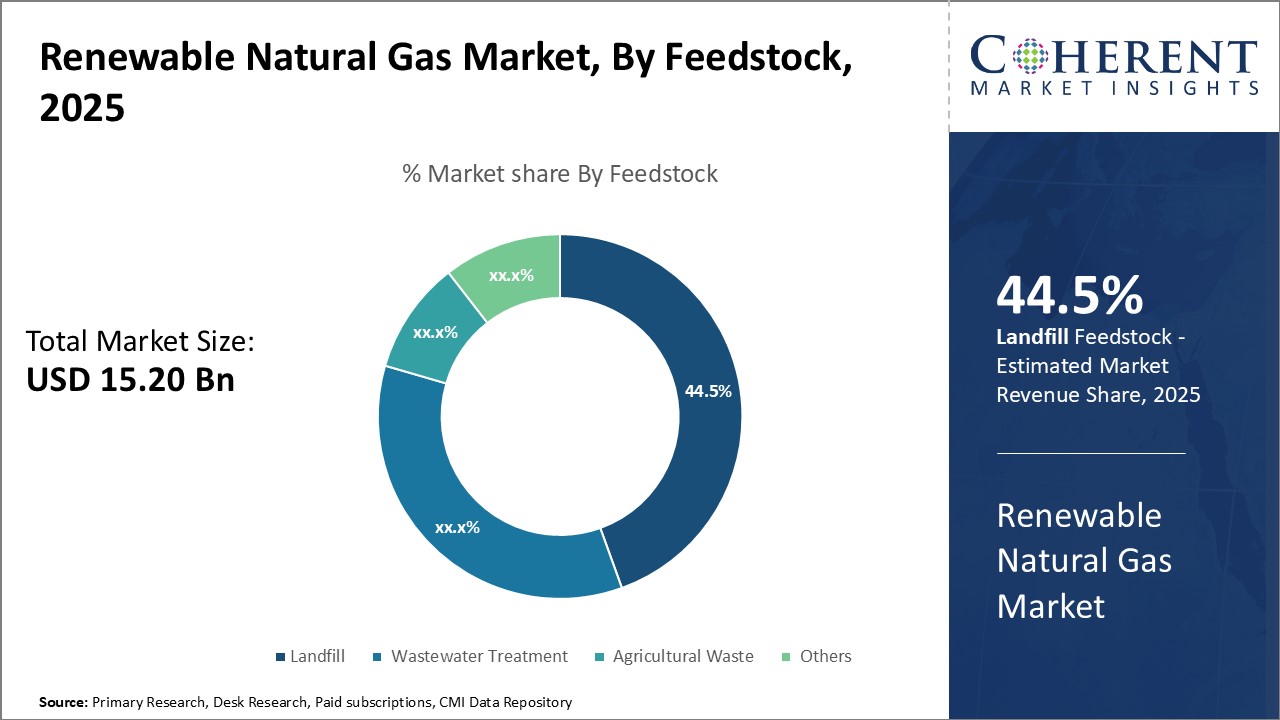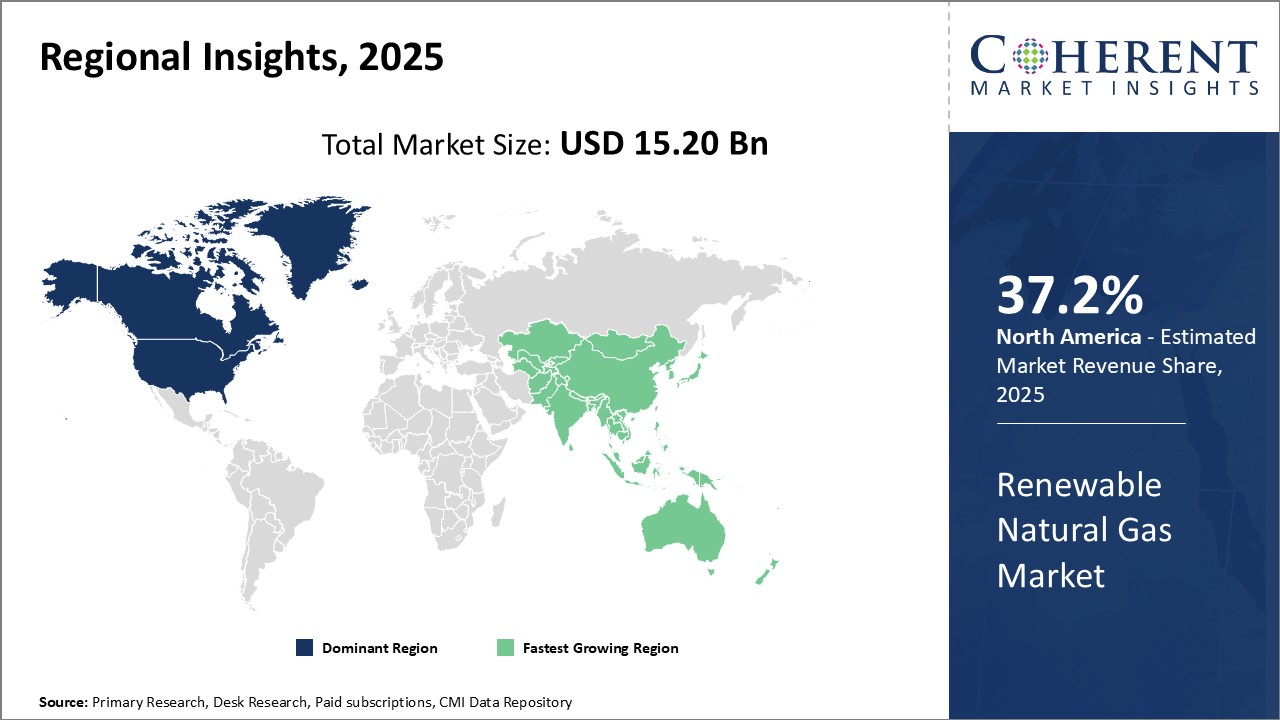Renewable Natural Gas Market Size and Trends
The global renewable natural gas market is estimated to be valued at USD 15.20 Bn in 2025 and is expected to reach USD 26.57 Bn by 2032, exhibiting a compound annual growth rate (CAGR) of 8.3% from 2025 to 2032.

Discover market dynamics shaping the industry: Download Free Sample
The growth in the global renewable natural gas market is driven by many countries and states increasing their renewable energy targets over the next decade. With continued expansion of waste-to-energy projects and growth of organic waste, the supply of renewable natural gas is expected to steadily rise to meet the growing demand. Many utilities and power generation companies are investing more in renewable natural gas projects as it helps them meet environmental regulations at a relatively low cost compared to other alternatives like hydrogen.
Market Driver - Government support and incentives
With the looming threats of climate change becoming more apparent, governments across the globe are focusing their policy efforts towards transitioning to more eco-friendly sources of energy. Renewable natural gas has emerged as a promising option that can leverage the existing infrastructure for natural gas while providing carbon neutral or negative options. Many jurisdictions have introduced financial incentives and policy support for the production and use of renewable natural gas, for instance, The Renewable Natural Gas Incentive Act of 2023 proposes to amend the Internal Revenue Code to increase the tax credit for renewable natural gas (RNG) used as a transportation fuel. The act aims to raise the credit to $1.00 per gallon for RNG sold for use in vehicles, aviation, or by the taxpayer. By enhancing the incentive for RNG production and consumption, the legislation seeks to drive job creation, economic expansion, and emissions reduction across various sectors. In North America, countries like the U.S. and Canada offer production tax credits and grants for setting up biogas plants and projects involving biomethane injection into natural gas pipelines. States and provinces also provide rebates and subsidies for businesses and consumers adopting renewable natural gas. This includes incentives for purchasing vehicles that can run on renewable natural gas. Such supportive policies and financial packages make renewable natural gas an attractive investment proposition and also reduce the cost of adoption, increasing its competitiveness against traditional natural gas.
In Europe as well, governments have rolled out renewable energy targets that consider biomethane and other forms of renewable natural gas as qualifying fuels. Financial incentives like carbon credits and feed-in-tariffs ensure producers of renewable gas can benefit. Italy, France, and Sweden too offer lucrative policy frameworks driving higher renewable natural gas consumption. Even in Asian nations, China and South Korea are formulating progressive policies around biogas and biomethane production from agriculture and municipal waste streams. With more commitments being made towards net-zero emissions globally, the incentives for transitioning to cleaner renewable fuels like natural gas are expected to further scale up in the coming years. This is anticipated to significantly boost investments and capacity additions in the renewable natural gas industry.
Market Concentration and Competitive Landscape

Get actionable strategies to beat competition: Download Free Sample
Demand for cleaner sources of energy
Around the world, businesses and consumers are embracing sustainable alternatives as climate change awareness grows. There is a strong preference for energy sources that offer carbon neutral or negative profiles compared to conventional fossil fuels. Renewable natural gas perfectly fits the bill as it can be easily integrated within existing natural gas infrastructure and provide a 'drop-in' clean replacement. As cities and industries aim for net-zero emissions targets over the next few decades, switching to renewable natural gas allows them to continue relying on familiar natural gas for various applications while meeting sustainability goals. Renewable gas provides carbon savings throughout the value chain from production to use.
Biomethane from organic wastes is increasingly seen as a viable method to transition existing natural gas users towards a greener option without major modifications. Utilities too are making investments to accommodate higher volumes of renewable gas into their networks to cater to customer needs. Even in the transport sector, renewable natural gas is emerging as a top alternative fuel for heavy-duty trucks and municipal fleets aiming to reduce their carbon footprint. As more emphasis is placed on the climate change mitigation capabilities of different fuels, renewable natural gas is attracting greater demand backed by its inherent environmental benefits over conventional sources. With a push for sustainability across end-use segments, demand momentum for renewable alternatives like natural gas is expected to really take off in the coming years.
Key Takeaways from Analyst:
The global renewable natural gas market is poised to grow substantially in the coming years driven by the rising environmental concerns around the world and the focus on reducing dependence on fossil fuels. Many countries have introduced renewable portfolio standards and climate change policies that mandate usage of renewables including renewable natural gas. The regulatory push for carbon neutral fuels will drive more projects related to production of renewable natural gas from waste streams and agricultural residues.
North America currently dominates the market owing to supportive federal and state level policies. The U.S. has seen significant increase in production capacity from projects related to landfill gas and anaerobic digestion of livestock waste. Europe is also focusing on bolstering renewable gas imports and domestic production capacity to meet climate targets.
However, high capital costs involved in setting up anaerobic digestion and landfill gas collection infrastructure could restrain market growth. Lack of standardized production pathways and technologies also pose a challenge. Seasonality of waste streams introduce intermittency issues. On the positive side, the opportunities lie in expansion of biogas upgrading facilities to produce pipeline quality biomethane. Increased usage of renewable natural gas as a transportation fuel can further boost demand.
Market Challenge - High capital investment requirement
One of the major challenges for the global renewable natural gas market is the need for high capital investment for setting up production facilities for renewable natural gas. Producing renewable natural gas from sources such as organic waste requires setting up digesters, storage tanks, pipelines, and other processing units. This level of infrastructure development requires huge initial capital that is a huge burden for companies and project developers. The high capital costs make renewable gas projects difficult to be financially viable. Raising capital from investors also becomes challenging given the long payback periods of such projects. The high capital expenditure poses entry barriers for new players and restricts the growth of production capacity additions in this renewable energy market. Unless mechanisms are developed to reduce capital costs through subsidies and incentives, or novel financing solutions are explored, high capital requirements will continue to hamper the large-scale development of the renewable natural gas industry globally.
Market Opportunity - Partnerships with Waste and Agriculture Industries
One of the key opportunities for the global renewable natural gas market lies in partnering with related waste and agriculture industries. Agricultural waste and organic municipal solid waste are prime sources of feedstock that can be used for producing renewable natural gas through anaerobic digestion. By tying up with companies and local bodies in charge of waste management, renewable gas developers can get assured supply of low-cost feedstock. Similarly, partnerships with farmers and agricultural cooperatives provide opportunities to tap waste from livestock and crop residues. Such strategic partnerships help renewable gas projects address one of the important challenges of securing sustainable feedstock supply. This also fosters synergies between different industries. When waste producers are also shareholders in gas projects, it leads to ‘circular economy’ with mutual economic and environmental benefits. Such collaborative models have potential to significantly boost renewable gas production volumes globally.

Discover high revenue pocket segments and roadmap to it: Download Free Sample
Insights by feedstock: Waste-based feedstock serves as a plentiful source of renewable natural gas
In terms of feedstock, landfill segment is estimated to dominate the market with 44.5% share of the market in 2025, owing to the abundance of waste-based feedstock available for conversion to renewable natural gas. Landfills receive billions of tons of municipal solid waste every year that undergoes anaerobic digestion to produce biogas containing methane. This methane can then be processed and upgraded into renewable natural gas. The availability of huge volumes of waste makes landfills a plentiful source of feedstock that faces little competition for use. Additionally, landfill gas capture and utilization help reduce greenhouse gas emissions and provides an environmentally sustainable means of waste management. Various government policies and incentives have encouraged greater landfill gas recovery for energy production. As awareness grows around renewable energies and carbon neutral fuels, landfills are poised to play a leading role in the renewable natural gas market through sustainable waste utilization.
Insights by application: Vehicle fuel helps lower emissions and decrease reliance on petroleum
In terms of application, vehicle fuel segment is estimated to hold 36.1% share of the market in 2025, owing to its potential to lower transport emissions and oil consumption. Renewable natural gas used as a vehicle fuel, typically compressed natural gas (CNG) or liquefied natural gas (LNG), provides a drop-in replacement for gasoline or diesel with significantly reduced carbon intensity. This allows fleet operators in industries like waste management and mass transit to lower their emissions profile cost-effectively without infrastructure changes. Use of renewable natural gas as a transport fuel also enhances energy security by displacing demand for petroleum imports. Government policies in regions like Europe and North America incentivize the uptake of renewable natural gas vehicles through subsidies and fuel standards. With the transportation sector accounting for a major share of emissions globally, the utilization of renewable gas for vehicles delivers sizable environmental benefits.
Regional Insights

Need a Different Region or Segment? Download Free Sample
North America has emerged as the dominant region in the global renewable natural gas market with an estimated 37.2% share in 2025. The U.S. has traditionally been at the forefront of adopting renewable and clean energy solutions. Strong policy support in the form of tax incentives, renewable fuel standards, and government mandates have promoted production and use of renewable natural gas over the last decade. Several large utilities and power producers have incorporated significant amounts of renewable gas into their fuel portfolio to meet environmental targets. An extensive pipeline network and distribution infrastructure allows for easy transportation of renewable gas from production sites to major demand centers across the country. With the highest capital investments and an established ecosystem of technology providers and project developers, North America accounts for the largest share of global renewable gas production capacity.
The Asia Pacific region is witnessing the fastest growth and has immense potential to become a frontrunner in the renewable natural gas market in the coming years. Countries like China, India, and Indonesia are aggressively promoting the adoption of cleaner fuels to address severe air pollution issues in their industrial and transportation sectors. Rapid economic expansion coupled with growing focus on reducing dependence on fossil fuel imports is driving strong government support for renewable energy projects. The availability of abundant feedstock from agricultural and municipal waste gives the region a distinct advantage. Furthermore, Asia Pacific has a young and expanding middle-class population which is expected to lead to considerable increase in energy demand that can potentially be met through domestic renewable gas production. Several initial pilot projects are underway and major infrastructure partnerships have been announced, which will help catapult the region to the top if backed by consistent policy mechanisms.
Market Report Scope
Renewable Natural Gas Market Report Coverage
| Report Coverage | Details | ||
|---|---|---|---|
| Base Year: | 2024 | Market Size in 2025: | USD 15.20 Bn |
| Historical Data for: | 2020 To 2024 | Forecast Period: | 2025 To 2032 |
| Forecast Period 2025 to 2032 CAGR: | 8.3% | 2032 Value Projection: | USD 26.57 Bn |
| Geographies covered: |
|
||
| Segments covered: |
|
||
| Companies covered: |
Clean Energy Fuels Corp., Biomethane Technologies, Fortistar, Waste Management, Inc., Renewable Energy Group, Inc., Duke Energy, EnviTec Biogas AG, Brightmark Energy, Aqua America, Inc., Gasrec, CNG Services Ltd., Calgren Renewable Fuels, Cypress Creek Renewables, RNG Energy Solutions, Greenlane Biogas, Sustainable Energy Solutions, Xebec Adsorption Inc., Agraferm Technologies AG, Ecovyst Inc., and Air Products and Chemicals, Inc. |
||
| Growth Drivers: |
|
||
| Restraints & Challenges: |
|
||
Uncover macros and micros vetted on 75+ parameters: Get instant access to report
Renewable Natural Gas Industry News
- In July 2024, Gevo, Inc., is a renewable energy company announced that its renewable natural gas (RNG) business has achieved record production levels, marking a significant milestone for the company. This accomplishment underscores Gevo's commitment to sustainable energy solutions and its role in the transition to renewable resources.
- In April 2024, Brightmark RNG Holdings, a joint venture between Chevron U.S.A. Inc. and Brightmark Fund Holdings LLC, announced the successful completion of its Eloy Development, marking the launch of renewable natural gas (RNG) production in the U.S. Southwest. This significant milestone underscores Brightmark's commitment to advancing sustainable energy solutions and enhancing the availability of renewable resources in the region.
- In July 2024, Global NRG Advisory, a leading energy consulting firm, announced the launch of its dedicated renewable natural gas (RNG) development platform. This strategic move aims to provide comprehensive support and expertise to clients seeking to develop and invest in RNG projects, further driving the growth of the renewable energy sector.
- In late 2022, Shell Petroleum acquired Nature Energy, a leading producer of RNG in Denmark, indicating the growing interest of major energy companies in expanding their RNG portfolios. Similarly, Green Rock Energy Partners acquired South Hills Landfill Gas Venture, further emphasizing the trend of integrating RNG into broader energy strategies
*Definition: The Global Renewable Natural Gas Market consists of companies that produce and sell natural gas generated from renewable sources like organic municipal waste, agricultural waste, and landfill waste or wastewater treatment plants. The renewable natural gas is collected from organic matter through anaerobic digestion or thermal gasification processes and then processed and purified to produce pipeline-grade renewable natural gas that can be used as a green alternative to fossil natural gas in various applications like vehicle fuel, home heating or power and others.
Market Segmentation
- Feedstock Insights (Revenue, USD Bn, 2020 - 2032)
- Landfill
- Wastewater Treatment
- Agricultural Waste
- Others
- Application Insights (Revenue, USD Bn, 2020 - 2032)
- Vehicle Fuel
- Power Generation
- Pipeline Injection
- Others
- Regional Insights (Revenue, USD Bn 2020 - 2032)
- North America
- U.S.
- Canada
- Latin America
- Brazil
- Argentina
- Mexico
- Rest of Latin America
- Europe
- Germany
- U.K.
- Spain
- France
- Italy
- Russia
- Rest of Europe
- Asia Pacific
- China
- India
- Japan
- Australia
- South Korea
- ASEAN
- Rest of Asia Pacific
- Middle East
- GCC Countries
- Israel
- Rest of Middle East
- Africa
- South Africa
- North Africa
- Central Africa
- North America
- Key Players Insights
- Clean Energy Fuels Corp.
- Biomethane Technologies
- Fortistar
- Waste Management, Inc.
- Renewable Energy Group, Inc.
- Duke Energy
- EnviTec Biogas AG
- Brightmark Energy
- Aqua America, Inc.
- Gasrec
- CNG Services Ltd.
- Calgren Renewable Fuels
- Cypress Creek Renewables
- RNG Energy Solutions
- Greenlane Biogas
- Sustainable Energy Solutions
- Xebec Adsorption Inc.
- Agraferm Technologies AG
- Ecovyst Inc.
- Air Products and Chemicals, Inc.
Share
Share
About Author
Yash Doshi is a Senior Management Consultant. He has 12+ years of experience in conducting research and handling consulting projects across verticals in APAC, EMEA, and the Americas.
He brings strong acumen in helping chemical companies navigate complex challenges and identify growth opportunities. He has deep expertise across the chemicals value chain, including commodity, specialty and fine chemicals, plastics and polymers, and petrochemicals. Yash is a sought-after speaker at industry conferences and contributes to various publications on topics related commodity, specialty and fine chemicals, plastics and polymers, and petrochemicals.
Missing comfort of reading report in your local language? Find your preferred language :
Transform your Strategy with Exclusive Trending Reports :
Frequently Asked Questions
EXISTING CLIENTELE
Joining thousands of companies around the world committed to making the Excellent Business Solutions.
View All Our Clients
